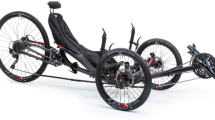Abstract
This paper presents a system named ExoBike, a structure similar to a bicycle, that takes over the function of an exoskeleton with rehabilitation purposes. The proposed system enables the control of limb movements based on the sensor data and the patient intentions. For that it has an adapted seat and several mechanical interface zones that have a set of sensors and actuators that enable therapeutics to implement an active/passive system that reacts dynamically to the needs of the disease under evaluation. The type and intensity of the training may be programmed by the medical staff that receives feedback in the software from the wireless sensors. The ExoBike allows the therapeutic professionals to put into practice adapted therapies with adjusted efforts for different patients. The patients’ movements are monitored using a set of wireless sensors network, implementing a personal virtual reality solution where the patient “play” in an environment strongly connected with reality.
Access this chapter
Tax calculation will be finalised at checkout
Purchases are for personal use only
Similar content being viewed by others
References
Abyarjoo, F., Barreto, A., Cofino, J., Ortega, F.R.: Implementing a sensor fusion algorithm for 3D orientation detection with inertial/magnetic sensors. In: Sobh, T., Elleithy, K., (eds.) Innovations and Advances in Computing, Informatics, Systems Sciences, Networking and Engineering. Lecture Notes in Electrical Engineering, vol. 313, pp. 305–310. Springer, Cham (2015)
Madgwick, S.O., Harrison, A.J., Vaidyanathan, R.: Estimation of IMU and MARG orientation using a gradient descent algorithm. In: Proceedings of IEEE International Conference on Rehabilitation Robotics, pp. 1–7 (2011). https://doi.org/10.1109/icorr.2011.5975346
Zhang, Z., Ji, L.Y., Huang, Z., Wu, J.: Adaptive information fusion for human upper limb movement estimation. IEEE Trans. Syst. Man Cybern. - Part A: Syst. Hum. 42(5), 1100–1108 (2012)
Rezvanian, S., Lockhart, T.E.: Towards real-time detection of freezing of gait using wavelet transform on wireless accelerometer data. Sensors 16(4), 475 (2016)
Oung, Q.W., Muthusamy, H., Lee, H.L., Basah, S.N., Yaacob, S., Sarillee, M., Lee, C.H.: Technologies for Assessment of motor disorders in Parkinson’s disease: a review. Sensors 15, 21710–21745 (2015). https://doi.org/10.3390/s150921710
Moore, S.T., MacDougall, H.G., Ondo, W.G.: Ambulatory monitoring of freezing of gait in Parkinson’s disease. J. Neurosci. Methods 167(2), 340–348 (2008)
Sabatelli, S., Galgani, M., Fanucci, L., Rocchi, A.: A double-stage Kalman filter for orientation tracking with an integrated processor in 9-D IMU. IEEE Trans. Instrum. Measur. 62(3), 590–598 (2013)
Greenleaf, W.J., Tovar, M.A.: Augmenting reality in rehabilitation medicine. Artif. Intell. Med. 6(4), 289–299 (1994). https://doi.org/10.1016/0933-3657(94)90034-5
Kuhlen, T., Dohle, C.: Virtual reality for physically disabled people. Comput. Biol. Med. 25(2), 205–211 (1995)
Kim, N.G., Yoo, C.K., Im, J.J.: A new rehabilitation training system for postural balance control using virtual reality technology. IEEE Trans. Rehabil. Eng. 7(4), 482–485 (1999)
Sveistrup, H.: Motor rehabilitation using virtual reality. J. NeuroEng. Rehabil. 1(1), 10 (2004)
Pfurtscheller, G., Neuper, C., Schlögl, A., Lugger, K.: Separability of EEG signals recorded during right and left motor imagery using adaptive autoregressive parameters. IEEE Trans. Rehabil. Eng. 6(3), 316–325 (1998)
Pires, G., Nunes, U., Castelo-Branco, M.: Statistical spatial filtering for a P300-based BCI: tests in able-bodied, and patients with cerebral palsy and amyotrophic lateral sclerosis. J. Neurosci. Methods 195(2), 270–281 (2011)
Acknowledgments
This work is co-financed by the European Regional Development Fund (ERDF), through the partnership agreement Portugal2020 – Regional Operation Program CENTRO2020, under the project SAICT-POL/24013/2016 ExoBike.
Author information
Authors and Affiliations
Corresponding author
Editor information
Editors and Affiliations
Rights and permissions
Copyright information
© 2019 Springer Nature Switzerland AG
About this paper
Cite this paper
Gomes, A. et al. (2019). Development of a Biomechanical Bike with Assistive Technologies to Be Used for Rehabilitation. In: Ahram, T., Karwowski, W., Taiar, R. (eds) Human Systems Engineering and Design. IHSED 2018. Advances in Intelligent Systems and Computing, vol 876. Springer, Cham. https://doi.org/10.1007/978-3-030-02053-8_147
Download citation
DOI: https://doi.org/10.1007/978-3-030-02053-8_147
Published:
Publisher Name: Springer, Cham
Print ISBN: 978-3-030-02052-1
Online ISBN: 978-3-030-02053-8
eBook Packages: Intelligent Technologies and RoboticsIntelligent Technologies and Robotics (R0)




